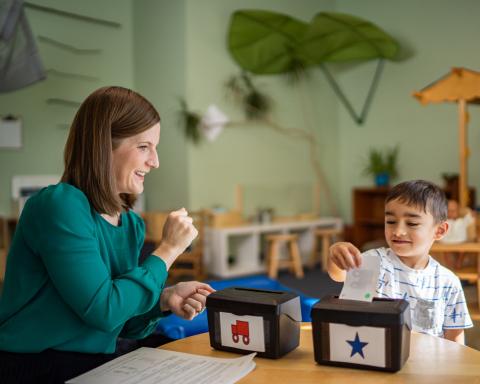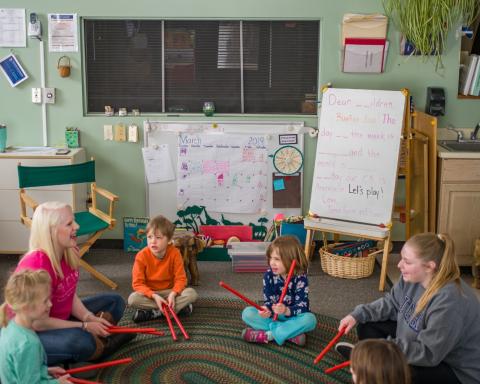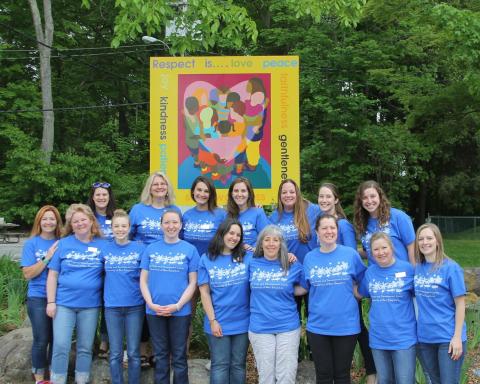The Child Study & Development Center (CSDC) is a laboratory school affiliated with the Department of Human Development and Family Studies (HDFS) at the University of New Hampshire. A laboratory school is one with both an early care and education mission and an academic mission. Children attending the center, and the UNH students working at the center, benefit from the highly trained teaching staff and from the HDFS faculty. Each year more than one hundred students enrolled in HDFS courses at UNH use the center as a laboratory for experimental teaching and learning, and documentation of those experiences. Students from other disciplines (i.e. education, psychology, occupational therapy, and communication disorders) also use the center as a laboratory for the study of children.
The CSDC was established in 1929 as a demonstration teaching site for UNH students. The current facility was built in 1988 and serves 122 children, aged 6 weeks to 5 years in 4 full-time classrooms and 3 part-time classrooms. There are 20 full-time highly qualified staff and about 35 UNH students employed part-time as Teaching Assistants each semester. The Center was accredited by the National Association for the Education of Young Children (NAEYC) in 1999 and is licensed by the State of NH. In addition to tuition revenues, the CSDC academic mission is supported by UNH College of Health and Human Services funds. The CSDC is known for its inquiry approach to early education.
The CSDC philosophy and pedagogical approach is rooted in the traditions of constructivist theory and practice. Since the early 1990s our center has been inspired by the ideas of early educators in Reggio Emilia, Italy, that emphasize the social construction of knowledge, the inquiry process of long terms investigations by learners, the role of symbolic languages in developing understanding, and the importance of reflecting family and culture in our environments. The children’s program is built upon the belief that children learn best when provided rich experiences that encourage collaborative inquiry and study of the world in which they live. Diverse materials and media are provided to them to support the many ways children represent knowledge. Taking an emergent/responsive curriculum approach, teachers act as learning partners and modify their practice in response to children’s questions, theories, and misconceptions.
The 10 NAEYC Program Standards

Our Missions
Early Childhood Education
Our mission is to design and provide developmentally and culturally appropriate programs that promote children’s development, support families, and are reflective of our community. An integral component of our curriculum is that children and teachers construct the content of the curriculum and the processes for learning in partnership through inquiry. We make a special effort to promote a diverse and inclusive community of learners.
Pre-Service Teaching
Our mission is to provide UNH students with excellent teacher training in early childhood education that parallels our work with children and families, as well as offer opportunities to learn about child and family development in a naturalistic setting. Each year more than one hundred students enrolled in Family Studies courses at UNH use the Center as a laboratory for experiential teaching and learning, and documentation of those experiences. Students from other disciplines, for example, education, psychology, occupational therapy, and communication disorders, also use the Center as a laboratory for the study of children.
Research & Outreach
Our mission is to engage directly in action research that supports our work with children, to provide the UNH community with access to a relevant research site, and to engage the broader professional community in learning about innovative early childhood practices. The seven classrooms in the center are equipped with observation booths that are used by college students, faculty, parents, and visitors. These booths provide researchers with the opportunity to observe children in a natural context. Research projects have ranged from the effects of infant child care on attachment to the development of emergent literacy. All research projects must be approved by the UNH Institutional Review Board and by the Associate director. The center hosts and annual conference and frequent tours by educators from across the country and internationally.

On the occasion of 75 years of educating young children and future teachers in 2004, the Child Study and Development Center (CSDC) at the University of New Hampshire embarked on a process of reflection about the identity of the center. One starting place for better understanding Where are we now? and Where are we going? is to look carefully at What came before?. Through this process we created a visual timeline, an Identity Card of sorts, that acts as a provocation for dialogue among teachers, faculty, families, community members, and, of course, children.
In addition to this more detailed photographic record and timeline, which is also displayed in our Community Room, we have included a much briefer history of the CSDC below.
The history of the CSDC mirrors many of the significant shifts in the broader society, including changing gender roles, the increasing participation of women in work outside the home, and challenges of cultural pluralism. More specifically, our center has often ridden the edge of the wave of innovations in early childhood education.
In January 1929, the Home Economics Department collaborated with the Durham Kindergarten Association to provide a laboratory for child development classes. Children from the private nursery school kindergarten attended the preschool. The University furnished the building, heat, light, maintenance, and the supervisor for the students taking the courses. In order to have the school near enough for university students to use, the program was set up in the location in what was called the “Practice House”.
In 1937, due to financial and administrative needs, the use of the Practice House as a nursery school was discontinued and the building was converted into a Craft Cottage. Weaving and other crafts, which had been a part of Home Economics, were transferred to the newly created Department of the Arts. In order that some work with children could be continued, one room in the new home management building, the Elizabeth DeMeritt House, was used to maintain a nursery school for six children.
In 1947, the small Home Economics Nursery School merged with the mother-run G.I. (Government Issued) Nursery in the College Road Apartments. In 1950, the Nursery School moved back to the Craft Cottage. There was one morning and one afternoon program for preschoolers. The student teachers’ primary role then was to observe through screened observation booths. A typical session included rest time on rugs, juice and story time. At that time there were only two courses taught in Child Development.
Shortly before 1980 a new program for toddlers was started, and in 1983 permanent positions with benefits were approved for two teachers. After years of discussion and development, the current facility was constructed in 1988, and full-day programs were initiated to offer year around services to children six weeks to five years of age. The existing nursery school programs also moved to the new facility, located at O’Kane Farm. In 1993 a full day kindergarten was added as a result of parent interest. The Child Study and Development Center (CSDC) was accredited by the National Association for the Education of Young Children (NAEYC) in 1999 and in 2005 celebrated 75 years of operation.
The CSDC philosophy and pedagogical approach is rooted in the traditions of constructivist theory and practice. Since the early 1990s our center has been inspired by the ideas of early educators in Reggio Emilia, Italy, that emphasize the social construction of knowledge, the inquiry process of long terms investigations by learners, the role of symbolic languages in developing understanding, and the importance of reflecting family and culture in our environments. The children’s program is built upon the belief that children learn best when provided rich experiences that encourage collaborative inquiry and study of the world in which they live. Diverse materials and media are provided to them to support the many ways children represent knowledge. Taking an emergent/responsive curriculum approach, teachers act as learning partners and modify their practice in response to children’s questions, theories, and misconceptions.
Today, CSDC offers a variety of programs for campus and community families in a single location, and provides a complete child development laboratory to educate students for all areas in which the Department of Human Development and Family Studies provides teacher education. A team of 20 teachers and staff provide quality care and education to 122 children between the ages of six weeks and six years. Currently, more than 120 majors are enrolled in the Young Child Option and the Nursery- Kindergarten Certification option of the Department of Human Development and Family Studies. Faculty and students from many University departments visit this laboratory school each year for the purposes of child study and research.
Our Vision and Goals for Children
We are committed to supporting each child at CSDC to:
- Develop curiosity, a sense of wonder, and a life-long love of learning;
- Be an effective communicator through language, literacy, and diverse forms of representation;
- Solve meaningful and challenging problems;
- Have a confident sense of self and an understanding of diversity in the world;
- Be a respectful and competent friend, community-member, and citizen.
Our Vision and Goals for Families
In developing a partnership with families we strive to:
- Ensure families feel welcomed and included as valued members of the CSDC community;
- Advocate for the best interests of all children and the CSDC community as a whole;
- Build trusting relationships that respect multiple perspectives, develop open and honest communication, and seek common ground;
- Involve families in understanding the mission, values and philosophy that guides our work with children;
- Invite families to participate in the curriculum and center activities in meaningful ways by sharing their resources, ideas, knowledge, and culture.
We believe that children and adults construct knowledge with others. Our primary goal is to create a pedagogy of collaborative inquiry--one in which teachers, children, and parents construct knowledge in relation as processes of learning are developed that support inquiry (e.g., resourcefulness, critical thinking, problem-solving, autonomy, and deliberate attention). Consequently, we strive to create group experiences in which children will develop relationships with people, materials, and space from which discoveries can be made. It is the responsibility of teachers to purposefully create and provoke rich experiences for child discovery and to extend previous, more serendipitous experiences that occur at home, school, and in the greater community. As such, teachers function as active partners with children and their parents so that the learning context is relevant and meaningful to the lives of children enrolled at the Child Study and Development Center.
We strive to respect and value the differences in each child and family in our community through all that we do. We value the development of strong relationships with families and colleagues in order to better understand how we can respond to cultural and historical differences in experiences, values, and practices. We offer an environment that welcomes and celebrates the sharing of family history and culture in the classroom in meaningful ways. In our curriculum we are intentional in providing children with opportunities to explore similarities and variation, and we are responsive to the questions that emerge.
We support children in being active participants in their world by connecting them to their community in ways that foster an understanding of diversity and an ability to effect change. We are committed to an open and ongoing dialogue among colleagues, families, and the students we mentor, seeking insight into how we contribute to social bias and the process of change. As adults we strive to be models of active participation in our field by speaking out against bias and seeking equity.
The CSDC community is committed to valuing individual differences and actively including children and families with a wide variety of racial, ethnic, family, religious, economic and cultural orientations, as well as children with a range of special needs and linguistic backgrounds. We believe that it is only by providing and supporting diversity within our classroom that we can enable children and adults to value the richness and importance of a multicultural education and world. The CSDC Diversity, Equity, and Bias Taskforce (D.E.B.T.) developed the following mission statement in 2005 that reflects these values and beliefs. The following mission was adopted by the CSDC staff to guide future initiatives:
“Lack of the free and equitable intercourse which springs from a variety of shared interests makes intellectual stimulation unbalanced. Diversity of stimulation means novelty, and novelty means challenge to thought.” John Dewey, 1916
We believe that human diversity is integral to the care and education of young children and to all those who touch their lives. Diversity at the University of New Hampshire can be defined as “a fully inclusive campus community that is enriched by persons of different races, genders, ethnicities, nationalities, economic backgrounds, ages, abilities, sexual orientation and gender identity or expression, and religious beliefs.” Our goal is to promote awareness and acceptance, affirm equity, and take an active stance against bias in our community.
We strive to respect and value the differences in each child and family in our community through all that we do. We value the development of strong relationships with families and colleagues in order to better understand how we can respond to cultural and historical differences in experiences, values, and practices. We offer an environment that welcomes and celebrates the sharing of family history and culture in the classroom in meaningful ways. In our curriculum we are intentional in providing children with opportunities to explore similarities and variation, and we are responsive to the questions that emerge.
We support children in being active participants in their world by connecting them to their community in ways that foster an understanding of diversity and an ability to effect change. We are committed to an open and ongoing dialogue among colleagues, families, and the students we mentor, seeking insight into how we contribute to social bias and the process of change. As adults we strive to be models of active participation in our field by speaking out against bias and seeking equity.
Directions
UNH Child Study and Development Center
22 O'Kane Rd
Durham, NH 03824
Phone: (603) 862-2835
Fax: (603) 862-0291
Email: csdc.info@unh.edu
From Boston, MA
Take I-95 North to Exit 4 (NH Lakes and Mountains, Spaulding Turnpike). Continue North to Exit 6W and follow Route 4 West. Exit at Route 155A and turn east toward Durham. Follow 155A. To CSDC: Take a left onto Mast Road (at the end of the field). The road will fork, go to the left- this is Spinney Lane. Follow this straight through the fields; you are now on O’Kane Road. You will see CSDC on your right as you drive past the fields. Follow the one way loop to the right and arrive at CSDC. Limited parking spaces are available in front. Upon arrival please stop in the main office, first door on your left as you enter the building, to check and sign in. (driving time, approx. 90 minutes)
From Portland, ME
Follow I-95 South to Exit 5. Continue on Spaulding Turnpike North to Exit 6W and follow Route 4 West. Follow directions as listed from Boston. (Driving time, approx. 60 minutes)
From Concord, NH
Take Route 4 East to the 155A exit. Follow directions as listed from Boston. (Driving time, approx. 45 minutes)
From Manchester, NH
Take Route 101 to Epping; go north on Route 125 to the Lee Traffic Circle. Drive East on Route 4 to the Route 155A exit. Follow directions as listed from Boston. (Driving time, approx. 45 minutes)




